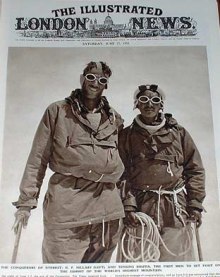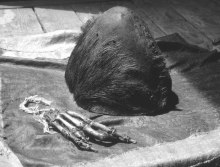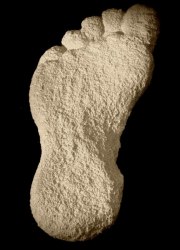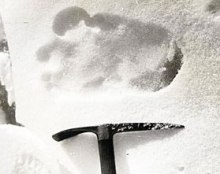In search of the Abominable Snowman.
All over the world there are strange stories about fierce wildmen. Giant ape-like creatures who supposedly live in remote areas, hiding in the wilderness.
 Illlustration of Yeti from the Anatomical Dictionary (for Recognizing Various Diseases), Peking edition, by Lovsan-Yondon and Tsend-Otcher, eighteenth century. Tibet.
Illlustration of Yeti from the Anatomical Dictionary (for Recognizing Various Diseases), Peking edition, by Lovsan-Yondon and Tsend-Otcher, eighteenth century. Tibet.
In Northwest-American folklore there are the Ts'emekwes, Skoocooms, Sasquatchand Bigfoot. From Siberia come reports of the elusive giant Chuchunya. Until his mysterious death in 2002, the Spanish crypto-zoologist Jordi Magraner studied a yeti-like creature called Barmanou in the northern Pakistani and Afghan mountain regions.
Out of all these so-called cryptids, the Himalayan Yeti is unquestionably the most famous.
The Yeti has been a part of the Tibetan mythology for hundreds of years. The Western world didn’t discover it until the 19th century when the British began exploring the Himalayas. One of the first Yeti accounts is found in Lieutenant Colonel Laurence Austine Waddell’s book Among the Himalayas [1889]. Waddell describes how he observes strange footprints in the snow by the lake Sikkim, at 16400 feet above sea level. According to Waddell’s local guides, the footprints had been made by a large ape-like creature they call Mi-go.
 Ruins of the ancient Gurugem Monastery, where, according to Jesuit missionaries, a map to the sacred city of Olmolungring was kept. Photo Karl Wienert 1938.
Ruins of the ancient Gurugem Monastery, where, according to Jesuit missionaries, a map to the sacred city of Olmolungring was kept. Photo Karl Wienert 1938.
The Yeti in Tibetan folklore
The pre-Buddhist shamanic mystics in the ancient Tibetan Bön religion called the Yeti Mi rgod and described it as a fury giant that makes a whistling sound. The Mi rgod’s were allegedly guardians of the hidden city Olmolungring, where the Old Gods were still dwelling and great libraries harboured ancient wisdom.
The Bön shamans were known to use the sacred blood of the Mi grod for various magical purposes. The Mi rgod was said to be able to lie dormant for a very long time, and according to the Bön mythology, it had also changed its shape several times since its creation. The Bön mystics claimed that, the Mi grod race was older than man.
The Lepcha people of Sikkim worshiped the Yeti as a hunting god in pre-Buddhist times. According to their myths, anyone who saw the Yeti often died or disappeared.
 Edmund Hillary and Tenzing Norgay on Mount Everest 1953.
Edmund Hillary and Tenzing Norgay on Mount Everest 1953.
Increasing reports
As more and more Westerners began making attempts to scale the many mountains of the Himalayas, reports of the Yeti became increasingly common.
In the book, Mount Everest The Reconnaissance, 1921, Howard-Bury includes an account of crossing the Lhakpa-la pass at 21,000 ft. where he found footprints that he believed "were probably caused by a large 'loping' grey wolf, which in the soft snow formed double tracks rather like a those of a bare-footed man".
He adds that his Sherpa guides "at once volunteered that the tracks must be that of The Wild Man of the Snows, to which they gave the name Metoh-kangmi".
Among the many other mountaineers who have reported evidence of the Yetis existence, are Edmund Hillary and the Sherpa Tenzing Norgay, who were the first to climb Mount Everest in 1953. Hillary claimed that he saw footprints made by the creature an altitude of more than 19 000 ft.
 The German Ernst Schäfer Expedition in Tibet. Photo Karl Wienert 1938.
The German Ernst Schäfer Expedition in Tibet. Photo Karl Wienert 1938.
The Nazi search for Atlantis
In 1938 the German organization Ahnenerbe, organized a expedition to Tibet. The famous German hunter and zoologist Ernst Schäfer was selected to lead the expedition. The official mission was to study Tibet's climate, geography and culture but many reliable sources claim that the expedition's true purpose was to search for the fabled cradle of the Aryan race, the ancient Atlantian colony, that Buddhists call Shambhala.
The expedition's anthropologist, Bruno Beger, was convinced that the secret road to Shambhala was guarded by ancient creatures, known to Buddhist sages as The Mi-go. Beger was confident that the search for the Mi-go would lead the expedition to Shambhala.
 The Yeti hand and scalp. Now returned to the Khumjung monastery.
The Yeti hand and scalp. Now returned to the Khumjung monastery.
The Schäfer expedition's results in the search for Mi-go and the lost city of Shambhala are debated. The rumours are many and the facts few, since much of the expedition's reports and files on the subject were lost or destroyed in the Second World War.
The pysical evidence
Despite numerous reports of footprints, and even eyewitness accounts from both locals and Western mountaineers and adventurers, there is little tangible physical evidence that "The Abominable Snowman” actually exists.
Among the physical evidence that has been presented, is a scalp that Edmund Hillary found in The Khumjung monastery in 1960, and the skeleton of a Yeti-hand that was smuggled to London by actor Jimmy Stewart 1957. Certain scientists have dismissed both objects as forgeries.
The best evidence so far is the photographs of footprints taken by mountaineer Eric Shapton in 1951. The images, taken at nearly 21,000 ft. above sea level showed clear footprints left by a two-legged creature.
No one has yet been able to prove that the photos are forgeries. Hairs, possibly from a Yeti, have also puzzled scientists, and are still classified as coming from an unknown Himalayan animal.
The Dr Oudot footprint
In The Dr Cagliostro collection there is a plaster cast of a strange footprint. The cast was purchased in 1954 and have allegedly belonged to a Dr Jacques Oudot. Dr Oudot participated in Maurice Herzog's Annapurna Expedition in 1950.
 Dr Oudot's plaster cast of the curious footprint. 1950.
Dr Oudot's plaster cast of the curious footprint. 1950.
The cast is about 19 inches long and 8,5 inches wide. According to estimates, a creature that makes such a print should be almost 10 feet tall and weigh nearly 40 stone.
In 1953 Dr Oudot tried to publish an article about his findings in the Journal de Chirurgie, but was refused. He was killed shortly afterwards in a car accident, only 39 years old.
We are presently negotiating with an anonymous source who has the only surviving manuscript of Dr Oudots article in his possession. We hope to soon be able to publish it, in connection with a planned exhibition of the strange footprint.
O. Hejll, Curator.





